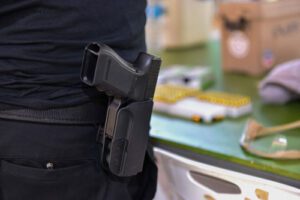 The District Court continued: For the reasons set forth above, the Court finds that at this stage of the proceeding the individual Plaintiffs have made a sufficient showing of standing. The Court therefore turns to the requirements under Federal Rule of Civil Procedure 65.
The District Court continued: For the reasons set forth above, the Court finds that at this stage of the proceeding the individual Plaintiffs have made a sufficient showing of standing. The Court therefore turns to the requirements under Federal Rule of Civil Procedure 65.
Likelihood of Success on the Merits – The State’s Historical Justification for the Challenged “Sensitive Places” As an initial matter, this Court echoes the observations made in Antonyuk v. Hochul, Civ. No. 22-0986 (Suddaby, J.), 2022 WL 5239895, at *14 (N.D.N.Y. Oct. 6, 2022) (considering a Second Amendment challenge to a similar law in New York that prohibited firearms in sensitive locations). First, although the Supreme Court in Bruen did not go so far as to restrict the definition of “sensitive places” to only government-sanctioned or affiliated places, it did indicate a skepticism as to expanding the definition of “sensitive places” based on the historical record. See Bruen, 142 S. Ct. at 2133 (indicating that “although the historical record yields relatively few 18th- and 19th-century “sensitive places” where weapons were altogether prohibited—e.g., legislative assemblies, polling places, and courthouse— we are also aware of no disputes regarding the lawfulness of such prohibitions”) (citations omitted); see also Antonyuk, 2022 WL 5239895, at *14. Thus, “sensitive place” is a term within the Second Amendment context that should not be defined expansively.
The Court’s second observation is that the plain text of the Second Amendment clearly covers the conduct at issue: “carrying a handgun in public for self-defense.” Id. (citing Bruen, 142 S. Ct. at 2150 (explaining that a historical analysis of public discourse during the Reconstruction “demonstrate[s] how public carry for self-defense remained a central component of the protection that the Fourteenth Amendment secured for all citizens”). Defendants dispute this proposition but seem to do so only with respect to the private property provision of Section 7(a)(24). To the extent Defendants challenge other provisions, they inject language into the legislation that does not exist. [See e.g., State’s Br. at 24 (suggesting As Plaintiffs point out, what is notable about these few “sensitive places” where weapons were prohibited is the long tradition of the government providing security. [Pls.’ Br. at 23–24.]
The foregoing paragraph is important for those of us trying to keep up with the ever-changing law regarding where guns cannot be carried, even with a permit-to-carry. It is important to note that ambiguous areas should be construed strictly and in favor of the permit-holder since the term “sensitive place” should not be construed expansively. On the other hand, the relatively few places in which the government provides security are more likely to be construed as “sensitive places” where handguns cannot be carried by permit holders.
